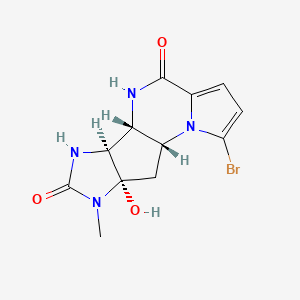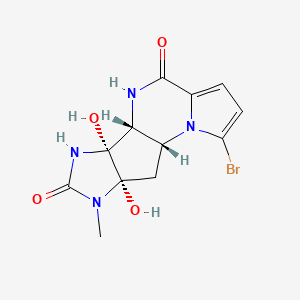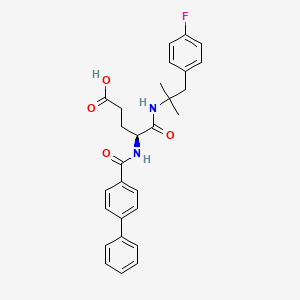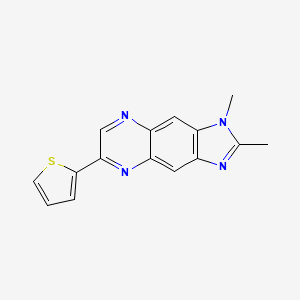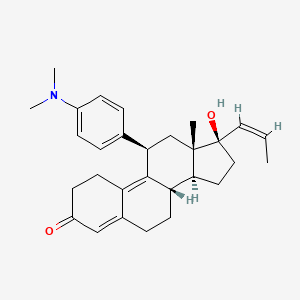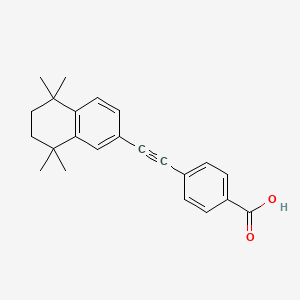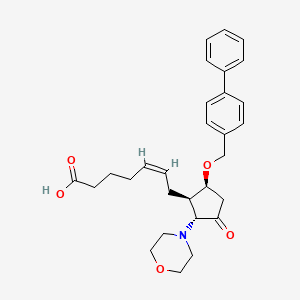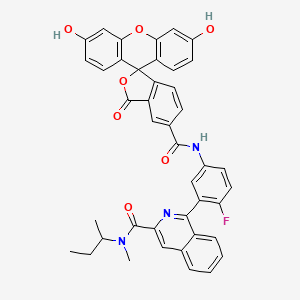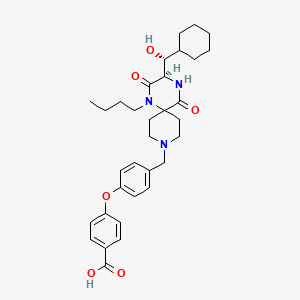
Aplaviroc
Vue d'ensemble
Description
L’aplaviroc est un composé appartenant à la classe des 2,5-dikétopiperazines. Il a été développé comme un inhibiteur de l’entrée CCR5 pour le traitement de l’infection par le VIH. Le composé a été conçu pour bloquer l’entrée du virus dans les cellules humaines en ciblant le récepteur CCR5, qui est un co-récepteur essentiel pour l’entrée du VIH-1 .
Méthodes De Préparation
Voies de Synthèse et Conditions de Réaction : La synthèse de l’aplaviroc implique plusieurs étapes, en commençant par la préparation du noyau spiro-dikétopiperazine. Ce noyau est ensuite fonctionnalisé avec divers substituants pour obtenir la structure finale. Les étapes clés comprennent :
- Formation du cycle dikétopiperazine.
- Introduction des groupes butyle et cyclohexyle.
- Attachement de la partie phénoxybenzoïque.
Méthodes de Production Industrielle : La production industrielle de l’this compound impliquerait probablement l’optimisation de la voie de synthèse pour maximiser le rendement et la pureté. Cela comprend l’utilisation de catalyseurs à haut rendement, des conditions de réaction contrôlées et des techniques de purification telles que la cristallisation et la chromatographie .
Analyse Des Réactions Chimiques
Types de Réactions : L’aplaviroc subit plusieurs types de réactions chimiques, notamment :
Oxydation : Le groupe hydroxyle sur le cycle cyclohexyle peut être oxydé en cétone.
Réduction : Le cycle dikétopiperazine peut être réduit dans des conditions spécifiques.
Substitution : Le groupe phénoxy peut être substitué par d’autres groupes fonctionnels.
Réactifs et Conditions Courants :
Oxydation : Réactifs tels que le permanganate de potassium ou le trioxyde de chrome.
Réduction : Réactifs comme le borohydrure de sodium ou l’hydrure de lithium et d’aluminium.
Substitution : Divers nucléophiles en milieu basique ou acide.
Principaux Produits : Les principaux produits formés à partir de ces réactions dépendent des conditions et des réactifs spécifiques utilisés. Par exemple, l’oxydation du groupe hydroxyle produirait une cétone, tandis que les réactions de substitution pourraient introduire une variété de groupes fonctionnels .
4. Applications de la Recherche Scientifique
L’this compound a été largement étudié pour son potentiel dans le traitement de l’infection par le VIH. Son application principale est d’inhiber l’entrée du virus dans les cellules humaines en bloquant le récepteur CCR5. Cela en fait un outil précieux dans les milieux cliniques et de recherche pour étudier les mécanismes d’entrée du VIH et développer de nouvelles stratégies thérapeutiques .
De plus, l’this compound a montré un potentiel dans d’autres domaines de recherche, tels que :
Chimie : Comme composé modèle pour étudier la chimie des spiro-dikétopiperazines.
Biologie : Pour étudier la biologie du récepteur CCR5 et son rôle dans diverses maladies.
Applications De Recherche Scientifique
Aplaviroc has been extensively studied for its potential in treating HIV infection. Its primary application is in inhibiting the entry of the virus into human cells by blocking the CCR5 receptor. This makes it a valuable tool in both clinical and research settings for studying HIV entry mechanisms and developing new therapeutic strategies .
Additionally, this compound has shown potential in other areas of research, such as:
Chemistry: As a model compound for studying spiro-diketopiperazine chemistry.
Biology: For investigating CCR5 receptor biology and its role in various diseases.
Mécanisme D'action
L’aplaviroc exerce ses effets en se liant au récepteur CCR5 à la surface des cellules humaines. Cette liaison empêche le virus VIH-1 de se fixer au récepteur, bloquant ainsi son entrée dans la cellule. Le composé agit comme un antagoniste allostérique non compétitif, ce qui signifie qu’il se lie à un site différent sur le récepteur que le ligand naturel, provoquant un changement conformationnel qui inhibe la fonction du récepteur .
Composés Similaires :
Maraviroc : Un autre antagoniste du CCR5 utilisé dans le traitement du VIH.
Vicriviroc : Un antagoniste du CCR5 en essais cliniques de phase tardive.
PRO140 : Un anticorps monoclonal contre le CCR5.
Comparaison : L’this compound est unique dans sa structure chimique, en particulier le noyau spiro-dikétopiperazine, qui le distingue des autres antagonistes du CCR5 comme le maraviroc et le vicriviroc. Bien que tous ces composés ciblent le même récepteur, le profil de liaison spécifique de l’this compound et son mécanisme d’inhibition allostérique présentent des avantages et des défis distincts, tels que son activité antivirale puissante et des problèmes d’hépatotoxicité .
Comparaison Avec Des Composés Similaires
Maraviroc: Another CCR5 antagonist used in HIV treatment.
Vicriviroc: A CCR5 antagonist in late clinical trials.
PRO140: A monoclonal antibody against CCR5.
Comparison: Aplaviroc is unique in its chemical structure, particularly the spiro-diketopiperazine core, which distinguishes it from other CCR5 antagonists like maraviroc and vicriviroc. While all these compounds target the same receptor, this compound’s specific binding profile and allosteric inhibition mechanism provide distinct advantages and challenges, such as its potent antiviral activity and issues with hepatotoxicity .
Propriétés
IUPAC Name |
4-[4-[[(3R)-1-butyl-3-[(R)-cyclohexyl(hydroxy)methyl]-2,5-dioxo-1,4,9-triazaspiro[5.5]undecan-9-yl]methyl]phenoxy]benzoic acid | |
|---|---|---|
| Source | PubChem | |
| URL | https://pubchem.ncbi.nlm.nih.gov | |
| Description | Data deposited in or computed by PubChem | |
InChI |
InChI=1S/C33H43N3O6/c1-2-3-19-36-30(38)28(29(37)24-7-5-4-6-8-24)34-32(41)33(36)17-20-35(21-18-33)22-23-9-13-26(14-10-23)42-27-15-11-25(12-16-27)31(39)40/h9-16,24,28-29,37H,2-8,17-22H2,1H3,(H,34,41)(H,39,40)/t28-,29-/m1/s1 | |
| Source | PubChem | |
| URL | https://pubchem.ncbi.nlm.nih.gov | |
| Description | Data deposited in or computed by PubChem | |
InChI Key |
GWNOTCOIYUNTQP-FQLXRVMXSA-N | |
| Source | PubChem | |
| URL | https://pubchem.ncbi.nlm.nih.gov | |
| Description | Data deposited in or computed by PubChem | |
Canonical SMILES |
CCCCN1C(=O)C(NC(=O)C12CCN(CC2)CC3=CC=C(C=C3)OC4=CC=C(C=C4)C(=O)O)C(C5CCCCC5)O | |
| Source | PubChem | |
| URL | https://pubchem.ncbi.nlm.nih.gov | |
| Description | Data deposited in or computed by PubChem | |
Isomeric SMILES |
CCCCN1C(=O)[C@H](NC(=O)C12CCN(CC2)CC3=CC=C(C=C3)OC4=CC=C(C=C4)C(=O)O)[C@@H](C5CCCCC5)O | |
| Source | PubChem | |
| URL | https://pubchem.ncbi.nlm.nih.gov | |
| Description | Data deposited in or computed by PubChem | |
Molecular Formula |
C33H43N3O6 | |
| Source | PubChem | |
| URL | https://pubchem.ncbi.nlm.nih.gov | |
| Description | Data deposited in or computed by PubChem | |
DSSTOX Substance ID |
DTXSID6047317 | |
| Record name | Aplaviroc | |
| Source | EPA DSSTox | |
| URL | https://comptox.epa.gov/dashboard/DTXSID6047317 | |
| Description | DSSTox provides a high quality public chemistry resource for supporting improved predictive toxicology. | |
Molecular Weight |
577.7 g/mol | |
| Source | PubChem | |
| URL | https://pubchem.ncbi.nlm.nih.gov | |
| Description | Data deposited in or computed by PubChem | |
Mechanism of Action |
GW873140 is a novel CCR5 receptor antagonist that binds specifically to human CCR5. It binds to human CCR5 with a unique profile as evidenced by the selective inhibition of monoclonal antibody binding. One of the many ways in which CCR5 inhibitors differ from the currently available classes of HIV drugs is that they bind to the host (CCR5 receptor), the cell, target rather than to the viral enzymes in cells like the CD4 cell. | |
| Record name | Aplaviroc | |
| Source | DrugBank | |
| URL | https://www.drugbank.ca/drugs/DB06497 | |
| Description | The DrugBank database is a unique bioinformatics and cheminformatics resource that combines detailed drug (i.e. chemical, pharmacological and pharmaceutical) data with comprehensive drug target (i.e. sequence, structure, and pathway) information. | |
| Explanation | Creative Common's Attribution-NonCommercial 4.0 International License (http://creativecommons.org/licenses/by-nc/4.0/legalcode) | |
CAS No. |
461443-59-4 | |
| Record name | Aplaviroc | |
| Source | CAS Common Chemistry | |
| URL | https://commonchemistry.cas.org/detail?cas_rn=461443-59-4 | |
| Description | CAS Common Chemistry is an open community resource for accessing chemical information. Nearly 500,000 chemical substances from CAS REGISTRY cover areas of community interest, including common and frequently regulated chemicals, and those relevant to high school and undergraduate chemistry classes. This chemical information, curated by our expert scientists, is provided in alignment with our mission as a division of the American Chemical Society. | |
| Explanation | The data from CAS Common Chemistry is provided under a CC-BY-NC 4.0 license, unless otherwise stated. | |
| Record name | Aplaviroc [INN] | |
| Source | ChemIDplus | |
| URL | https://pubchem.ncbi.nlm.nih.gov/substance/?source=chemidplus&sourceid=0461443594 | |
| Description | ChemIDplus is a free, web search system that provides access to the structure and nomenclature authority files used for the identification of chemical substances cited in National Library of Medicine (NLM) databases, including the TOXNET system. | |
| Record name | Aplaviroc | |
| Source | DrugBank | |
| URL | https://www.drugbank.ca/drugs/DB06497 | |
| Description | The DrugBank database is a unique bioinformatics and cheminformatics resource that combines detailed drug (i.e. chemical, pharmacological and pharmaceutical) data with comprehensive drug target (i.e. sequence, structure, and pathway) information. | |
| Explanation | Creative Common's Attribution-NonCommercial 4.0 International License (http://creativecommons.org/licenses/by-nc/4.0/legalcode) | |
| Record name | Aplaviroc | |
| Source | EPA DSSTox | |
| URL | https://comptox.epa.gov/dashboard/DTXSID6047317 | |
| Description | DSSTox provides a high quality public chemistry resource for supporting improved predictive toxicology. | |
| Record name | APLAVIROC | |
| Source | FDA Global Substance Registration System (GSRS) | |
| URL | https://gsrs.ncats.nih.gov/ginas/app/beta/substances/98B425P30V | |
| Description | The FDA Global Substance Registration System (GSRS) enables the efficient and accurate exchange of information on what substances are in regulated products. Instead of relying on names, which vary across regulatory domains, countries, and regions, the GSRS knowledge base makes it possible for substances to be defined by standardized, scientific descriptions. | |
| Explanation | Unless otherwise noted, the contents of the FDA website (www.fda.gov), both text and graphics, are not copyrighted. They are in the public domain and may be republished, reprinted and otherwise used freely by anyone without the need to obtain permission from FDA. Credit to the U.S. Food and Drug Administration as the source is appreciated but not required. | |
Retrosynthesis Analysis
AI-Powered Synthesis Planning: Our tool employs the Template_relevance Pistachio, Template_relevance Bkms_metabolic, Template_relevance Pistachio_ringbreaker, Template_relevance Reaxys, Template_relevance Reaxys_biocatalysis model, leveraging a vast database of chemical reactions to predict feasible synthetic routes.
One-Step Synthesis Focus: Specifically designed for one-step synthesis, it provides concise and direct routes for your target compounds, streamlining the synthesis process.
Accurate Predictions: Utilizing the extensive PISTACHIO, BKMS_METABOLIC, PISTACHIO_RINGBREAKER, REAXYS, REAXYS_BIOCATALYSIS database, our tool offers high-accuracy predictions, reflecting the latest in chemical research and data.
Strategy Settings
| Precursor scoring | Relevance Heuristic |
|---|---|
| Min. plausibility | 0.01 |
| Model | Template_relevance |
| Template Set | Pistachio/Bkms_metabolic/Pistachio_ringbreaker/Reaxys/Reaxys_biocatalysis |
| Top-N result to add to graph | 6 |
Feasible Synthetic Routes
Avertissement et informations sur les produits de recherche in vitro
Veuillez noter que tous les articles et informations sur les produits présentés sur BenchChem sont destinés uniquement à des fins informatives. Les produits disponibles à l'achat sur BenchChem sont spécifiquement conçus pour des études in vitro, qui sont réalisées en dehors des organismes vivants. Les études in vitro, dérivées du terme latin "in verre", impliquent des expériences réalisées dans des environnements de laboratoire contrôlés à l'aide de cellules ou de tissus. Il est important de noter que ces produits ne sont pas classés comme médicaments et n'ont pas reçu l'approbation de la FDA pour la prévention, le traitement ou la guérison de toute condition médicale, affection ou maladie. Nous devons souligner que toute forme d'introduction corporelle de ces produits chez les humains ou les animaux est strictement interdite par la loi. Il est essentiel de respecter ces directives pour assurer la conformité aux normes légales et éthiques en matière de recherche et d'expérimentation.


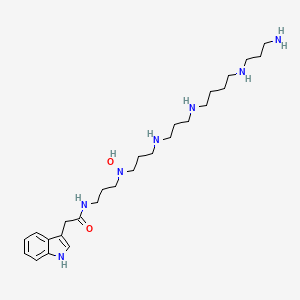

![16-[5-[5-[4,5-Dihydroxy-6-(hydroxymethyl)-3-(3,4,5-trihydroxyoxan-2-yl)oxyoxan-2-yl]oxy-3,4-dihydroxy-6-(hydroxymethyl)oxan-2-yl]oxy-3,4-dihydroxy-6-(hydroxymethyl)oxan-2-yl]oxy-5',7,9,13-tetramethylspiro[5-oxapentacyclo[10.8.0.02,9.04,8.013,18]icosane-6,2'-oxane]-10-one](/img/structure/B1665062.png)

![2-Ethoxy-4-[2-[[3-methyl-1-(2-piperidin-1-ylphenyl)butyl]amino]-2-oxoethyl]benzoic acid](/img/structure/B1665065.png)
